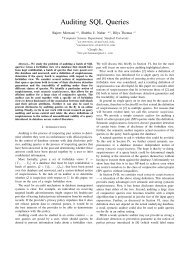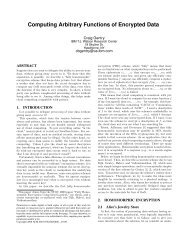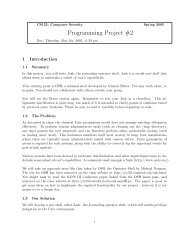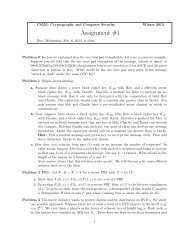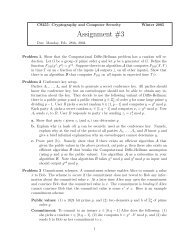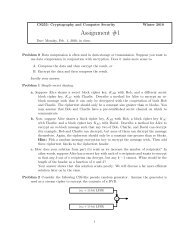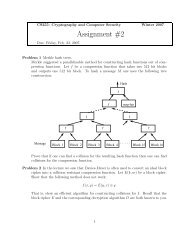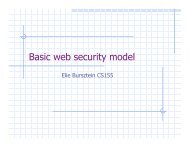slides - Stanford Crypto Group
slides - Stanford Crypto Group
slides - Stanford Crypto Group
Create successful ePaper yourself
Turn your PDF publications into a flip-book with our unique Google optimized e-Paper software.
Instantiating Random Oracles<br />
Mihir Bellare<br />
Joint work with Sriram Keelveedhi<br />
UCSD<br />
1/9/13 Bellare, <strong>Stanford</strong> RWC Workshop<br />
via UCEs<br />
1
The work reported on here is very much work in<br />
progress. The UCE definition has evolved since<br />
this talk and will evolve further, and what is here<br />
should not be taken as its definitive or final form.<br />
Theorems stated here have been strengthened,<br />
and we have other results as well. A paper is not<br />
yet available but we hope to have one soon.<br />
1/9/13 Bellare, <strong>Stanford</strong> RWC Workshop 2
Contributions in brief<br />
UCE (Universal Computational Extractors): A new DEFINITION of security<br />
for hash functions.<br />
Instantiating ROs: UCE hash functions can provably instantiate ROs in a<br />
variety of existing schemes: DE, HE, MLE, PKE (OAEP), KDM, RKA, …<br />
Generalization: UCE extends and unifies existing definitions like hardcore<br />
functions, extractors, correlated-input functions, …<br />
Modular design: Instantiate RO in (existing and) practical ROM schemes,<br />
not design new schemes!<br />
Modular proofs: (Instantiable RO paradigm): Proofs of instantiated schemes<br />
use results on the ROM security of the scheme in a blackbox way.<br />
1/9/13 Bellare, <strong>Stanford</strong> RWC Workshop<br />
3
Random Oracle Model (ROM) and Paradigm<br />
[BR93]<br />
Access to this procedure given to<br />
scheme algorithms as well as to the<br />
adversary.<br />
Step 1: Prove security of scheme in the ROM<br />
Step 2: Instantiate HASH via a cryptographic hash function H<br />
in an implementation<br />
The instantiated scheme is then secure as long as H<br />
behaves “like a random oracle.”<br />
1/9/13 Bellare, <strong>Stanford</strong> RWC Workshop<br />
4
RSA-OAEP<br />
[BR94]<br />
Theorem: In the ROM, RSA-OAEP is<br />
• IND-CPA secure if RSA is 1-way [BR94]<br />
• IND-CCA secure if RSA is partial-domain 1-way [FOPS01]<br />
In PKCS#1: Implemented with<br />
1/9/13 Bellare, <strong>Stanford</strong> RWC Workshop<br />
M || 0…0<br />
HASH<br />
HASH<br />
s t<br />
r<br />
5
ROM Features<br />
Yields schemes that are<br />
• Practical and<br />
• Proven secure<br />
ROM paradigm is<br />
• Widely employed<br />
• Works in practice<br />
Theory<br />
1/9/13 Bellare, <strong>Stanford</strong> RWC Workshop<br />
6
ROM Critiques<br />
Step 1: Prove security of scheme in the ROM.<br />
Step 2: Instantiate HASH via a cryptographic<br />
hash function H in an implementation.<br />
The instantiated scheme is then secure as long<br />
as H behaves “like a random oracle.”<br />
1/9/13 Bellare, <strong>Stanford</strong> RWC Workshop<br />
The ROM proof does not apply<br />
to the instantiated scheme<br />
It is not clear what this means.<br />
7
Counter-examples<br />
Theorem: [CGH98,MRH04] There exist<br />
encryption schemes that are<br />
• Secure in the ROM<br />
• Insecure under any instantiation of<br />
HASH<br />
The scheme in which HASH is instantiated by H can be broken if a<br />
program implementing H is the message M encrypted.<br />
Counter-examples that are (perhaps?) more realistic: Ni02,<br />
GT03, BBP04, CGH04, BDWY12, BCPT13, …<br />
1/9/13 Bellare, <strong>Stanford</strong> RWC Workshop<br />
8
The debate continues …<br />
The RO paradigm is<br />
theoretically unsound.<br />
It can yield insecure<br />
instantiated schemes.<br />
It’s too easy.<br />
We developed all this nice, deep,<br />
complex theory, and you want to replace<br />
it with a noise box.<br />
1/9/13 Bellare, <strong>Stanford</strong> RWC Workshop<br />
Your counter-examples are artificial.<br />
The paradigm has not failed in practice.<br />
You have some alternative?<br />
9
RSA+ROM q-ABDHE assumption<br />
1/9/13 Bellare, <strong>Stanford</strong> RWC Workshop<br />
10
The core problem: Lack of a definition<br />
Step 1: Prove security of scheme in the ROM.<br />
Step 2: Instantiate HASH via a cryptographic<br />
hash function H in an implementation.<br />
The instantiated scheme is then secure as long<br />
as H behaves “like a random oracle.”<br />
The ROM proof does not apply<br />
to the instantiated scheme<br />
It is not clear what this means.<br />
We lack a formal DEFINITION of what it<br />
means for a hash function to behave “like a<br />
random oracle.”<br />
1/9/13 Bellare, <strong>Stanford</strong> RWC Workshop<br />
11
The core problem: Lack of a definition<br />
Step 1: Prove security of scheme in the ROM.<br />
Step 2: Instantiate HASH via a cryptographic<br />
hash function H in an implementation.<br />
The instantiated scheme is then secure as long<br />
as H behaves “like a random oracle.”<br />
The ROM proof does not apply<br />
<strong>Crypto</strong>graphers don’t mind to the strong instantiated assumptions. scheme But<br />
they like to know exactly what they are assuming.<br />
It is not clear what this means.<br />
We lack a formal DEFINITION of what it<br />
means for a hash function to behave “like a<br />
random oracle.”<br />
1/9/13 Bellare, <strong>Stanford</strong> RWC Workshop<br />
12
Want: Instantiable RO Paradigm<br />
Step 1: Prove security of scheme in the ROM<br />
Step 2: Instantiate HASH via a cryptographic hash function H<br />
in an implementation<br />
Step 3: Prove that the instantiated scheme is secure as<br />
long as H meets definition X.<br />
We cannot hope to find (achievable) X where this works for ALL schemes.<br />
But we would like to cover interesting sub-classes of schemes.<br />
1/9/13 Bellare, <strong>Stanford</strong> RWC Workshop<br />
Exploiting the result of Step 1 in a blackbox way!<br />
Game-based, falsifiable definition in the standard style.<br />
Tells us when an attack on H is successful.<br />
13
Previous work<br />
X = PRF: [GGM86]<br />
Works for symmetric cryptography, where adversary does<br />
NOT have access to HASH oracle.<br />
X = POWHF (Perfectly One-Way Hash Functions): [C97,CMR98]<br />
X = Non-malleable hash functions: [BCFW09]<br />
X = CIH (Correlated-input-secure hash functions): [GOR11]<br />
Limited applicability.<br />
1/9/13 Bellare, <strong>Stanford</strong> RWC Workshop<br />
14
Contributions in brief<br />
UCE (Universal Computational Extractors): A new DEFINITION of security<br />
for hash functions.<br />
Instantiating ROs: UCE hash functions can provably instantiate ROs in a<br />
variety of existing schemes: DE, HE, MLE, PKE (OAEP), KDM, RKA, …<br />
Generalization: UCE extends and unifies existing definitions like hardcore<br />
functions, extractors, correlated-input functions, …<br />
Modular design: Instantiate RO in (existing and) practical ROM schemes,<br />
not design new schemes!<br />
Modular proofs: (Instantiable RO paradigm): Proofs of instantiated schemes<br />
use results on the ROM security of the scheme in a blackbox way.<br />
1/9/13 Bellare, <strong>Stanford</strong> RWC Workshop<br />
15
Syntax<br />
A family of hash functions is a pair of poly-time<br />
algorithms.<br />
Usually ignore<br />
Think HMAC-SHA1, not SHA1.<br />
1/9/13 Bellare, <strong>Stanford</strong> RWC Workshop<br />
16
UCE<br />
x1 x x 2<br />
n S<br />
H K<br />
H K<br />
Y 1<br />
Y 0 : random<br />
Informally: Y 1 looks random.<br />
H K<br />
Source<br />
1/9/13 Bellare, <strong>Stanford</strong> RWC Workshop<br />
Y b<br />
17
UCE<br />
x1 x x 2<br />
n S<br />
H K<br />
H K<br />
Y 1<br />
Y 0 : random<br />
H K<br />
Informally: Y 1 looks random given L.<br />
Source Leakage<br />
is UCE-secure if is negligible for every polytime<br />
S and every poly-time D.<br />
1/9/13 Bellare, <strong>Stanford</strong> RWC Workshop<br />
Y b<br />
L<br />
K<br />
D<br />
b'<br />
Distingsuisher<br />
18
UCE<br />
x1 x x 2<br />
n S<br />
H K<br />
H K<br />
Y 1<br />
Y 0 : random<br />
H K<br />
Source Leakage<br />
is UCE-secure if is negligible for every polytime<br />
S and every poly-time D.<br />
Not possible! L could contain x 1 and D could check whether H K(x 1)<br />
equals the first component of vector Y b.<br />
1/9/13 Bellare, <strong>Stanford</strong> RWC Workshop<br />
Y b<br />
L<br />
K<br />
D<br />
b'<br />
19
UCE<br />
x1 x x 2<br />
n S<br />
H K<br />
H K<br />
Y 1<br />
Y 0 : random<br />
H K<br />
Source Leakage<br />
is UCE-secure if is negligible for every polytime<br />
unpredictable S and every poly-time D.<br />
Y b<br />
Computing any x i given L is hard.<br />
Informally: Y 1 looks random given L as long as you cannot compute any x i.<br />
1/9/13 Bellare, <strong>Stanford</strong> RWC Workshop<br />
L<br />
K<br />
D<br />
b'<br />
20
UCE: Formally<br />
is UCE-secure if is negligible for every polytime<br />
unpredictable S and every poly-time D.<br />
1/9/13 Bellare, <strong>Stanford</strong> RWC Workshop<br />
22
The unpredictability condition: Formally<br />
S is unpredictable if is negligible for every poly-time U.<br />
Note: The hash function H appears nowhere; unpredictability is in<br />
the ROM.<br />
1/9/13 Bellare, <strong>Stanford</strong> RWC Workshop<br />
23
UCE generalizes existing definitions<br />
1/9/13 Bellare, <strong>Stanford</strong> RWC Workshop<br />
24
UCE generalizes existing definitions<br />
Definition Leakage Unpredictability Indistinguishability Correlated<br />
inputs<br />
Hardcore functions<br />
[BlMi81,Y82]<br />
Y b, F(x i) Computational Computational No<br />
Hardcore functions on<br />
correlated inputs [FOR12] Y b, F(x i) Computational Computational Yes<br />
Randomness extractors<br />
[NZ93,DORS08]<br />
Computational extractors<br />
[FPZ08,K10,DGKM12]<br />
Correlated-input secure<br />
functions [GOR11]<br />
Y b, F(x i) Statistical Statistical No<br />
Y b Statistical Computational No<br />
Y b Statistical Computational Yes<br />
UCE [BK13] Any Computational Computational Yes<br />
1/9/13 Bellare, <strong>Stanford</strong> RWC Workshop<br />
25
UCE generalizes existing definitions<br />
Definition Leakage Unpredictability Indistinguishability Correlated<br />
inputs<br />
Hardcore functions<br />
[BlMi81,Y82]<br />
Y b, F(x i) Computational Computational No<br />
Hardcore functions on<br />
correlated inputs [FOR12] Y b, F(x i) Computational Computational Yes<br />
Randomness extractors<br />
[NZ93,DORS08]<br />
Computational extractors<br />
[FPZ08,K10,DGKM12]<br />
Correlated-input secure<br />
functions [GOR11]<br />
Y b, F(x i) Statistical Statistical No<br />
Y b Statistical Computational No<br />
Y b Statistical Computational Yes<br />
UCE [BK13] Any Computational Computational Yes<br />
Definition Leakage Unpredictability Privacy<br />
Correlated<br />
inputs<br />
DE [BBO07,BFOR08] Y b Statistical Computational Yes<br />
DE with auxiliary inputs<br />
[BrSe11]<br />
Y b, F(x) Computational Computational Yes<br />
1/9/13 Bellare, <strong>Stanford</strong> RWC Workshop<br />
26
UCE extends standard definitions<br />
1/9/13 Bellare, <strong>Stanford</strong> RWC Workshop<br />
UCE:<br />
• Considers a more general form of<br />
leakage than other primitives<br />
• Goes “computational” on all fronts.<br />
27
UCE: Features and Limitations<br />
Allows instantiation of ROs when the inputs to which the<br />
good parties apply the RO are unknown (unpredictable) to<br />
the adversary.<br />
Good for many forms of encryption: DE, HE, MLE, PKE,<br />
KDM, RKA, …<br />
Does not handle CCA.<br />
Does not handle signatures, IBE.<br />
The hard part is usually to prove unpredictability of the<br />
source. But this is a ROM claim!<br />
1/9/13 Bellare, <strong>Stanford</strong> RWC Workshop 28
Deterministic PKE [BBO07]<br />
coins<br />
R-PKE<br />
IND-CPA<br />
D-PKE<br />
PRIV<br />
Semantic-security on unpredictable,<br />
pk-independent messages.<br />
D-PKE provides efficiently searchable encryption of<br />
records in outsourced databases.<br />
1/9/13 Bellare, <strong>Stanford</strong> RWC Workshop 29
Instantiating EwH<br />
ROM EwH D-PKE scheme [BBO07]:<br />
D-PKE R-PKE<br />
coins<br />
Theorem [BBO07]: If is IND-CPA-secure and is a RO then<br />
is PRIV-secure.<br />
Theorem [BK13]: If is IND-CPA-secure and H is UCE-secure then<br />
the instantiated scheme<br />
is PRIV-secure.<br />
First standard-model PRIV-secure D-PKE scheme.<br />
Previous standard model schemes achieved security for restricted<br />
sources [BoFeON08,BrSe11,FuONRe12].<br />
1/9/13 Bellare, <strong>Stanford</strong> RWC Workshop 30
Why it works<br />
We will make crucial use of:<br />
b<br />
Random challenge bit.<br />
A 1<br />
M<br />
Theorem [BFOR08]: PRIV ≡ IND<br />
(pk,K)<br />
Vector of messages, each component<br />
message having high min-entropy. Vector of ciphertexts formed by<br />
component-wise encryption.<br />
1/9/13 Bellare, <strong>Stanford</strong> RWC Workshop<br />
C<br />
A 2<br />
b'<br />
31
Why it works<br />
Claim 1: S is unpredictable<br />
b<br />
If not, one-wayness of the ROM scheme is violated.<br />
Claim 2:<br />
A 1<br />
By PRIV-security of the ROM scheme.<br />
1/9/13 Bellare, <strong>Stanford</strong> RWC Workshop<br />
M<br />
(pk,K)<br />
C<br />
A 2<br />
b'<br />
32
Why it works<br />
b<br />
A 1<br />
M<br />
(pk,K)<br />
Proofs of both Claims exploit in a blackbox way the<br />
known PRIV-security of the ROM scheme from [BBO07].<br />
Claim 1: S is unpredictable<br />
If not, one-wayness of the ROM scheme is violated.<br />
Claim 2:<br />
By PRIV-security of the ROM scheme.<br />
1/9/13 Bellare, <strong>Stanford</strong> RWC Workshop<br />
C<br />
A 2<br />
b'<br />
33
More instantiations in the same vein …<br />
Hedged PKE [BBNRSSY09] provides the best possible privacy in the face<br />
of system RNG failures.<br />
We can instantiate the RO in the Hedged PKE scheme of [BBNRSSY09].<br />
Message-Locked Encryption (MLE) [BKR12] allows secure de-duplicated<br />
storage. CE [DABST02] is a practical MLE scheme proven secure in the<br />
ROM by [BKR12].<br />
Presentation Friday 3:15pm!<br />
We can instantiate the RO in the CE MLE scheme.<br />
1/9/13 Bellare, <strong>Stanford</strong> RWC Workshop<br />
34
OAEP [BR94]<br />
Theorem: In the ROM, OAEP is<br />
• IND-CPA secure if f is one-way<br />
[BR94]<br />
• IND-CCA secure if f is partialdomain<br />
one-way [FOPS01]<br />
M || 0…0<br />
HASH<br />
HASH<br />
s t<br />
r<br />
Theorem [BK13]: If H is UCE-secure<br />
then instantiated OAEP is<br />
• IND-CPA' secure if f is partialdomain<br />
one-way<br />
IND-CPA for messages not depending on the public key.<br />
Note: One-way and partial-domain one-way are equivalent for RSA [FOPS01].<br />
Previous work: [KOS10] show RSA-OAEP is IND-CPA-secure<br />
under a weaker assumption on H (t-wise independence) and a<br />
stronger assumption on RSA (ϕ-hiding).<br />
1/9/13 Bellare, <strong>Stanford</strong> RWC Workshop<br />
39
Multi-key UCE<br />
We also give a definition of UCE-security for the case that hashing is being<br />
performed with many different keys.<br />
We do not know whether single-key UCE-security implies multi-key UCEsecurity<br />
in general. (The hybrid argument breaks down.)<br />
However, we can show that single key UCE-security implies multi-key<br />
UCE-security in the case that the number of keys is a constant.<br />
We exploit multi-key security in a crucial way for instantiating the RO in the<br />
[BRS03] KDM-secure encryption scheme and in RKA-secure encryption.<br />
1/9/13 Bellare, <strong>Stanford</strong> RWC Workshop<br />
40
KDM-secure encryption [CL01,BRS02]<br />
Definition of security for keydependent<br />
messages<br />
[BRS02] in which this<br />
is chosen by the adversary<br />
BRS02 scheme:<br />
Instantiated scheme, first try:<br />
Encryption key<br />
1/9/13 Bellare, <strong>Stanford</strong> RWC Workshop<br />
g<br />
Symmetric encryption.<br />
Randomized.<br />
Theorem [BRS02]: If is a<br />
RO then is KDM-secure.<br />
This won’t work!<br />
For UCE, M cannot depend on K.<br />
But for KDM, it must.<br />
41
KDM-secure encryption [CL01,BRS02]<br />
Definition of security for keydependent<br />
messages<br />
[BRS02] in which this<br />
is chosen by the adversary<br />
BRS02 scheme:<br />
Our instantiated scheme:<br />
Encryption key<br />
1/9/13 Bellare, <strong>Stanford</strong> RWC Workshop<br />
g<br />
Symmetric encryption.<br />
Randomized.<br />
Theorem [BRS02]: If is a<br />
RO then is KDM-secure.<br />
Theorem [BK13]: If H is multi-key<br />
UCE-secure then is nonadaptive<br />
KDM-secure.<br />
42
UCE hash functions from ROs<br />
Theorem [BK13]: If is a RO then is<br />
(multi-key) UCE-secure.<br />
In practice, instantiate via a cryptographic hash function.<br />
DE HE PKE KDM<br />
Standard model<br />
reductions<br />
PKE . . .<br />
UCE<br />
RO<br />
1/9/13 Bellare, <strong>Stanford</strong> RWC Workshop<br />
. . .<br />
Standard model<br />
definition<br />
43
Strength of UCE<br />
Is UCE too ``close’’ to the applications derived from it?<br />
• Perhaps true in some cases (DE, HE, MLE) yet the proofs are not<br />
completely direct<br />
• Less so in other cases (OAEP, KDM)<br />
We did not realize prior to UCE that all these applications relied on the<br />
same properties of the RO.<br />
1/9/13 Bellare, <strong>Stanford</strong> RWC Workshop<br />
44
Pairing-based cryptography<br />
IBE<br />
Short<br />
Signatures<br />
<strong>Group</strong><br />
Signatures<br />
BDHI<br />
Generic group model<br />
This paradigm works!<br />
Get new capabilities.<br />
Understand what we assume.<br />
Use falsifiable, standard-model assumptions.<br />
Broadcast<br />
Encryption ABE NIZK<br />
Subgroup<br />
Decision<br />
Why has ROM-based cryptography not taken a similar direction?<br />
1/9/13 Bellare, <strong>Stanford</strong> RWC Workshop<br />
. . .<br />
Issues and counter-examples similar to (or<br />
worse than!) those for the ROM [Fi00,De02]<br />
45<br />
. . . BDH LIN q-SDH BDDHE
A vision of ROM-based cryptography<br />
SE DE HE PKE MLE KDM RKA<br />
CIH<br />
Random Oracle model<br />
1/9/13 Bellare, <strong>Stanford</strong> RWC Workshop<br />
. . . PRF POWHF UCE<br />
. . .<br />
46
UCE hash functions from ``standard’’ assumptions?<br />
Natural target: Independent inputs; block sources. Potentially useful:<br />
• Lossy TDFs [PW08] as used in [BoFeON08,BrSe11]<br />
• Augmented Crooked LHL [KOS10]<br />
Goldreich-Levin hardcore bits fail for correlated inputs.<br />
We expect achieving (full) UCE-security under standard assumptions<br />
to be challenging since it implies several things not yet known to be<br />
achievable under standard assumptions.<br />
1/9/13 Bellare, <strong>Stanford</strong> RWC Workshop<br />
47
UCE hash functions from ``standard’’ assumptions?<br />
[RSS11] draws attention to how the number of stages of an adversary<br />
can affect achievability of notions of security.<br />
A UCE adversary is multi-stage.<br />
[Wi13] implies that proving UCE based on an assumption that is a<br />
challenger-adversary game may be hard. This<br />
• Rules out achieving UCE based on assumptions with single-stage<br />
adversaries<br />
• But does not rule out achieving it from assumptions that involve<br />
multi-stage adversaries.<br />
1/9/13 Bellare, <strong>Stanford</strong> RWC Workshop<br />
48
Contributions in brief<br />
UCE (Universal Computational Extractors): A new DEFINITION of security<br />
for hash functions.<br />
Instantiating Ros: UCE hash functions can provably instantiate ROs in a<br />
variety of existing schemes: DE, HE, MLE, PKE (OAEP), KDM, RKA, …<br />
Generalizaton: UCE extends and unifies existing definitions like hardcore<br />
functions, extractors, correlated-input functions, …<br />
Modular design: Instantiate RO in (existing and) practical ROM schemes,<br />
not design new schemes!<br />
Modular proofs: (Instantiable RO paradigm): Proofs of instantiated schemes<br />
use results on the ROM security of the scheme in a blackbox way.<br />
1/9/13 Bellare, <strong>Stanford</strong> RWC Workshop<br />
49




